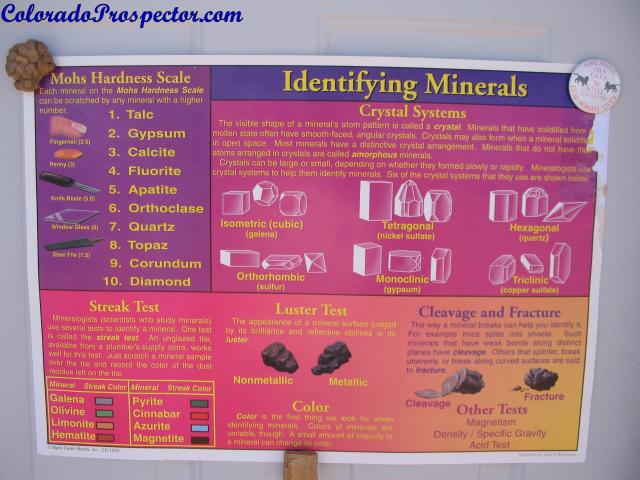Printable Version of Topic
Click here to view this topic in its original format
Colorado Prospector - Gem and mineral prospecting and mining forums _ Prospectors and Rockhounding Field Work _ Mohs Hardness
Posted by: ColoradoProspector Jan 8 2008, 11:15 AM
Mohs scale of hardness is a great tool to help Id stuff we all find.
Lets have a look at what that is and how we can use it in the field.
Also we will compare Mohs scale to "absolute" hardness which gives us more of an idea how much each hardness differs......you will be suprised. ![]()
Here's some info about Mohs from Wikipedia's pages....
For example, if some material is scratched by apatite but not by fluorite, its hardness on the Mohs scale would fall between 4 and 5.
Now.....Onto common test materials used.........
On the Mohs scale, a pencil lead has a hardness of - 1
a fingernail has hardness - 2.5
a copper penny, about - 3.5
a knife blade - 5.5
window glass - 5.5
steel file - 6.5
Using these ordinary materials of known hardness can be a simple way to approximate the position of a mineral on the scale.
And the Mohs Scale itself along side what is called "absolute" hardness.
Mohs..............Mineral....................Absolute
1----------------------Talc--------------------------1
2---------------------Gypsum----------------------2
3----------------------Calcite-----------------------9
4----------------------Fluorite----------------------21
5----------------------Apatite----------------------48
6-------------Orthoclase/Feldspar-----------72
7----------------------Quartz----------------------100
8----------------------Topaz-----------------------200
9---------------------Corundum-------------------400
10--------------------Diamond--------------------1500
You can view the page at http://en.wikipedia.org/wiki/Mohs_scale_of_mineral_hardness for lots more information on this.
CP
Posted by: russau Jan 10 2008, 05:25 AM
i need to laminate this scale to keep in my trailer. i keep losing the other ones that i had.thankyou!
Posted by: ColoradoProspector Jan 21 2008, 02:42 PM
You are very welcome Russ. ![]()
Now for all of you reading this thread and checkin' out the wiki info........
What is harder than 10?
![]()
CP
Posted by: russau Jan 22 2008, 05:09 AM
11???? or Fullerite <10 and <10 aggregated diamond nanorods
Posted by: jim Jan 22 2008, 08:41 AM
All five of my kids heads.
Posted by: Mrs.CP May 10 2008, 04:03 PM
I wonder where they get that from Jim.....hehe ![]()
Im going to pin this topic. Shouldnt have to dig for good info.
![]()
Posted by: russau May 11 2008, 05:36 AM
a good idea for this is to add it to your mineral identification kit if you have one. it consists of all the common items that you can readily get to do you scratch test. these atleast allow you to narrow the choices down to a smaller group to identify.i also have a book that i bought thatll help me narrow them down further. but still i have problems getting it correct.even the picture here on this site(kids corner) will help narrow your choices. but a lot of minerals (to me) look alike still!
Posted by: GeneYo May 11 2008, 08:25 AM
The easiest way to remember the Mohs Scale of Hardness is to the memorize this sentence:
Texas Girls Can Fix All Fools Quailing The Cowboys Dream.
T (Texas) = Talc
G (Girls) = Gympsum
C (Can) - Calcilte
F (Fix) = Feldspar
A (All) = Apatite
F (Fools) = Feldspar
Q (Quailing) = Quartz
T (The) = Topaz
C (Cowboys) = Corundum
D (Dream) = Diamond
Remember this sentence and you'll be able to quote the Mohs Scale of Hardness whenever needed.
While this is nothing I carry you can purchase hardness testers which are nothing more than a case containing scribes of different hardness corresponding to the Mohs Scale of Hardness.
Posted by: russau May 13 2008, 04:50 AM
that dont work for me! when i start saying that i get as far as Texas girls and my mind starts wandering!
Posted by: Mrs.CP Oct 19 2008, 01:24 PM
Another tip when testing for hardness........
When using a penny, make sure you use a copper one made in 1982 or before.
Posted by: ColoradoProspector Dec 17 2008, 09:31 AM
Russ got it right too........Fullerite and diamond nanorods, those are 10+ on the Mohs scale. Very interesting how they create them too.
Great info everyone! ![]()
Posted by: Mrs.CP Jul 28 2012, 01:51 PM
Here is a chart that we have. It varies a bit from the Wiki page with the hardness scale but I think this one is correct. ![]()
Please correct me if I'm wrong.
Posted by: Denise Feb 8 2023, 07:57 PM
Some great info in this thread for those looking to help identify some of their finds. ![]()
Powered by Invision Power Board (http://www.invisionboard.com)
© Invision Power Services (http://www.invisionpower.com)
